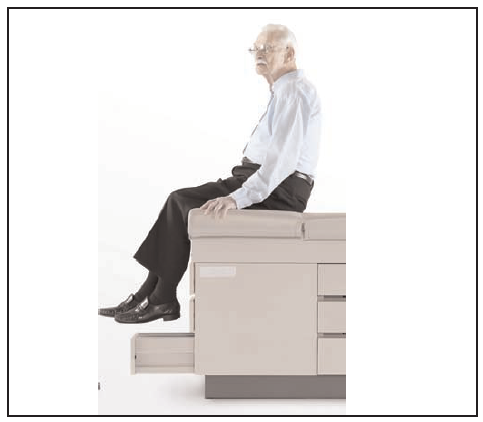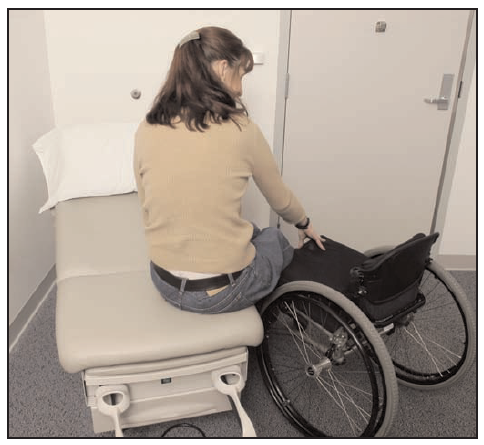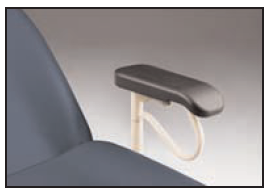3.2 Getting on the Table
The national survey also found that 75% of 291 people with experience using examination tables had moderate or greater difficulty using them. The height of exam tables was the most commonly reported complaint.4 A survey of approximately 400 Californians with disabilities found exam tables were inaccessible to 69% of wheelchair users, and 46% of cane, crutch and walker users.5
When getting health care, you usually have to get on and off of different types of equipment like tables and chairs. Many of these chairs and tables are high, which may be helpful to the doctor, nurse or technician, but difficult to impossible for you. If you cannot get onto the equipment, you may not get a thorough examination. Accessible tables and chairs that lower to 17-20 inches from the floor to the top of the cushion can make getting on and off them easier.
Traditional high exam table
Wheelchair user transferring onto accessible exam table
An accessible table is height adjustable to a minimum height of 17- 20 inches from the floor. Additional helpful features include an extra-wide top surface and higher weight capacity for larger people, adjustable side rails, positioning straps, and foot and leg supports that can be adjusted and locked.
Removable and adjustable side rail
For more information on accessible tables and a list of manufacturers, visit the Internet at http://www.cdihp.org/briefs/brief1-exam-tables.html. You can use this Internet document as a source of information for your doctor.
Holly uses a wheelchair. For quite a while she had been looking for a physician with a exam table that lowers to 17- 20 inches from the floor. Many of her co-workers went to physicians at a large and well-respected women’s clinic, so Holly called to ask if they had an accessible exam table. They said they did, so she made an appointment, excited that she had finally found a physician. When she arrived, she discovered that the table was not really accessible, it only lowered slightly and she couldn’t transfer onto it by herself. Holly reluctantly agreed to have two nurses lift her on the table for her exam, but they lifted her incorrectly. She fell and one of the nurses injured her back. Holly was okay, but she was embarrassed and upset and left without getting the exam.
Holly later felt she needed to do something about the problem, so she found the name of an accessible exam table manufacturer on the Internet and ordered a brochure. Holly sent the brochure and a letter to the clinic requesting that they purchase an accessible table. She was pleased when later they did purchase one.
There are important reasons for health care providers to have accessible examination and treatment tables and you can list these when talking to your doctor.
-
An accessible table allows for a more thorough exam, as compared to an exam where you remain seated in your wheelchair or on a chair.
-
A thorough exam can improve your chances of having any problems recognized and diagnosed, and allow any needed treatment to begin as early as possible. For example, some wheelchair users are at risk for developing pressure sores that may be missed if the individual cannot be examined on the exam table.
-
-
An accessible table reduces potential injuries to staff who may lift or help people transfer onto and off the equipment.
-
An accessible table is easier for everyone to use including patients who are obese, who have arthritis, older adults, pregnant women and anyone with a temporary or chronic condition that makes getting on a standard-height table difficult.
4 Kailes, J.I. (2006). The Patient’s Perspective on Access to Medical Equipment. In J. Winters and M. Story (Ed.), Medical Instrumentation: Accessibility and Usability Considerations (pp. 3-14). Boca Raton, FL: CRC Press.
5 Markwalder, A., Disability Rights Advocates (2005). A CALL TO ACTION: A Guide for Managed Care Plans Serving Californians with Disabilities. Oakland, CA: DRA




User Comments/Questions
Add Comment/Question